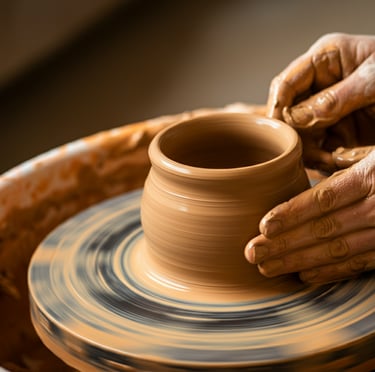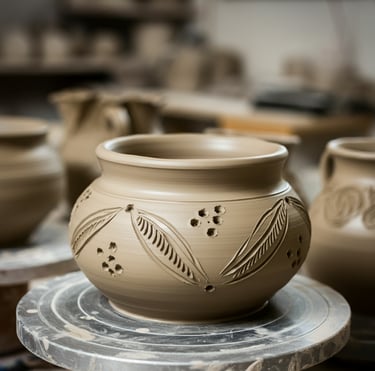From Earth to Art: Masterpieces in Clayware
CRAFTSMANSHIP & TECHNIQUES


Pottery, one of humanity's most ancient and persistent crafts, has maintained a vital role in human culture for millennia. Artisans skillfully convert ordinary clay into functional, aesthetically pleasing, and culturally expressive artifacts. The art of pottery exemplifies human intelligence, inventiveness, and the capacity to transform fundamental materials (earth) into artistic expressions. Throughout history, pottery has transformed into both a utilitarian and ornamental art form, but its essence persists: it embodies the intricate interplay of hand, earth, and fire.
An Art Form Grounded on the Soil
The process of making pottery starts with the essential material: clay. For millennia, potters have extracted clay from riverbanks, mountainsides, and subterranean deposits, where its pliable consistency makes it suitable for molding. This basic material, present in many shapes and hues based on its surroundings, embodies the spirit of its origin. Each clay variety has specific features, differing in texture, color, and consistency, which provide a unique identity and origin signature to the pottery.
Before creating any shape, potters must polish the clay, preparing it for wheel- or hand-building methods. This meticulous method, unaltered for generations, facilitates the transition from soil to art. As the potter manipulates the clay, they engage in a conversation with the material— an intimate interaction between the creator and the natural world. As the potter shapes the clay on the wheel, it responds by ascending and descending, revealing its inherent potential.
This bond with the ground is important for pottery. In contrast to other art forms that may seem detached from their fundamental elements, pottery is a craft that emerges from the direct engagement between the earth and the creative spirit. The potter's hands, shaped by centuries of tradition, transform earth into jars, bowls, vases, and ornamental items that fulfill both useful and artistic roles.
Convergence of Tradition and Innovation
Historically, pottery has transcended mere practicality. It has functioned as a vehicle for cultural expression, mirroring the beliefs, customs, and identities of communities globally. From the elaborate designs of Moroccan pottery to the minimalist, refined contours of Japanese Raku pottery, each culture has developed its style and methodology in pottery-making. These styles, often inherited through generations, embody the historical significance and narratives of their creators.
Moroccan pottery is known for its vivid colors and complex geometric patterns, many of which possess profound symbolic significance. These patterns, shaped by the profound Berber heritage and subsequent Islamic art, tell tales of regional identity and historical design traditions. Likewise, Japanese Raku pottery, characterized by its organic textures and erratic finishes, embodies the nation's profound reverence for nature and the aesthetic value of imperfection. Every piece of Raku pottery is distinctive, influenced by the interaction of natural elements and the artist's intent.
Although these historic methods are highly esteemed and maintained, contemporary potters persist in expanding the limits of the trade. The contemporary ceramic landscape amalgamates traditional and modern elements as artists explore avant-garde shapes, glaze techniques, and striking motifs. Pottery is experiencing a revival as modern artists discover innovative methods to revitalize this old trade. These contemporary works often obscure the distinction between use and artistry, converting mundane items into masterpieces.
Nevertheless, despite the advancements and novel methodologies, the fundamental nature of pottery remains constant. The link between hand, earth, and fire is a relationship that has persisted for millennia. Despite exploring innovative concepts, contemporary potters maintain a profound connection to the traditions that have influenced the art for centuries.
The Internal Blaze
The firing process is when the genuine transformation of pottery occurs. Each pottery item undergoes a metamorphosis in the kiln, where extreme heat transforms delicate clay into resilient ceramic after molding. This technique, capable of attaining temperatures up to 2,000 degrees Fahrenheit, hardens the pottery's structure and produces the exquisite, often surprising surface patterns and colors that make each piece distinctive.
The kiln, which is often regarded as the core of a pottery studio, is critical in determining the final result of the item. Ancient wood-fired kilns, for instance, provide an element of uncertainty to the operation. In these kilns, the flames and smoke engage with the pottery, imparting nuanced markings and color variations that are unreplicable. Pottery is distinctive because each item is a unique creation, molded by the potter's hands and influenced by natural forces.
Firing not only hardens the clay but also causes the applied glazes to melt and amalgamate with the surface, resulting in a glass-like gloss. These glazes, often composed of natural substances, may produce a diverse array of colors and textures. In traditional pottery techniques, such as Japanese Raku, the firing process is integral to artistic expression, with the final outcome being as much a consequence of the kiln as it is of the artist's craftsmanship.
Contemporary Pottery
In the contemporary era, characterized by mass manufacturing and throwaway items, pottery exemplifies the lasting significance of artisanal skill. A meticulously crafted bowl or vase infuses warmth and uniqueness into everyday life, providing a testament to the enduring significance of human craftsmanship. Pottery, in contrast to several contemporary objects, embodies a feeling of stability and history. Every item, whether utilitarian or ornamental, constitutes a masterpiece crafted by human hands and influenced by the natural environment.
The revival of pottery indicates an increasing need for sustainable and significant goods. Contemporary potters dedicate themselves to environmentally sustainable practices, crafting their works using local resources and eco-friendly techniques. Contrary to the ephemeral culture of mass-produced items, pottery provides a sustainable and enduring alternative. Pottery transcends mere aesthetics; it involves crafting something that may be treasured for a lifetime.
By endorsing pottery and other handcrafted items, buyers contribute to the preservation of traditional art forms and the sustenance of small-scale craftspeople. Numerous potters now operate inside cooperatives or tiny studios, sometimes depending on local communities for assistance. Acquiring pottery from these craftsmen not only supports the industry but also helps to sustain their livelihoods, as many are committed to maintaining their cultural heritage.
Transitioning from Earth to Art
Pottery, with its extensive historical significance, exemplifies the transformation of a basic material like clay into art. The allure of pottery is not only in the finished piece but also in the creative process, which links the artisan to the land and a rich heritage spanning generations. Whether inherited through centuries or innovatively conceived by modern artists, the fundamental nature of pottery remains unchanged: it transforms basic materials into something remarkable.
In a society sometimes seen as estranged from nature and tradition, ceramics shows that art may remain intimately related to the quotidian. Occasionally, the most significant expressions of art originate from the ground below us. Pottery, which embodies a harmony of use and aesthetics, tradition and modernity, always inspires and fascinates, highlighting the enchantment that arises from the fusion of creation and nature.
This ancient skill, fundamentally connected to the land and ignited by invention, illustrates the human spirit and our capacity to transform basic materials into beauty. Pottery, after millennia, continues to possess the ability to elevate the mundane to the remarkable.


